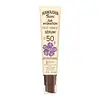What's inside
What's inside
 Key Ingredients
Key Ingredients

 Benefits
Benefits

 Concerns
Concerns

 Ingredients Side-by-side
Ingredients Side-by-side

Homosalate 9%
Skin ConditioningOctocrylene 6.5%
UV AbsorberEthylhexyl Salicylate 4.5%
UV AbsorberButyl Methoxydibenzoylmethane 3%
UV AbsorberWater
Skin ConditioningSilica
AbrasivePropylene Glycol
HumectantCetyl Dimethicone
EmollientPhenoxyethanol
PreservativeMica
Cosmetic ColorantSodium Polyacrylate
AbsorbentAcrylates/C12-22 Alkyl Methacrylate Copolymer
Caprylyl Glycol
EmollientTitanium Dioxide
Cosmetic ColorantParfum
MaskingChlorphenesin
AntimicrobialGlycerin
HumectantDisodium EDTA
Aloe Barbadensis Leaf Juice
Skin ConditioningSodium Hyaluronate
HumectantHibiscus Sabdariffa Flower Extract
Skin ConditioningCarica Papaya Fruit Extract
Skin ConditioningMangifera Indica Fruit Extract
Skin ConditioningPassiflora Incarnata Fruit Extract
Skin ConditioningPlumeria Acutifolia Flower Extract
Skin ConditioningPsidium Guajava Fruit Extract
AstringentHomosalate 9%, Octocrylene 6.5%, Ethylhexyl Salicylate 4.5%, Butyl Methoxydibenzoylmethane 3%, Water, Silica, Propylene Glycol, Cetyl Dimethicone, Phenoxyethanol, Mica, Sodium Polyacrylate, Acrylates/C12-22 Alkyl Methacrylate Copolymer, Caprylyl Glycol, Titanium Dioxide, Parfum, Chlorphenesin, Glycerin, Disodium EDTA, Aloe Barbadensis Leaf Juice, Sodium Hyaluronate, Hibiscus Sabdariffa Flower Extract, Carica Papaya Fruit Extract, Mangifera Indica Fruit Extract, Passiflora Incarnata Fruit Extract, Plumeria Acutifolia Flower Extract, Psidium Guajava Fruit Extract
Water
Skin ConditioningCyclopentasiloxane
EmollientZinc Oxide
Cosmetic ColorantEthylhexyl Methoxycinnamate
UV AbsorberButylene Glycol
HumectantDiethylhexyl Succinate
EmollientPolymethylsilsesquioxane
Hydrated Silica
AbrasiveGlycerin
HumectantLauroyl Lysine
Skin ConditioningLauryl PEG-9 Polydimethylsiloxyethyl Dimethicone
Skin ConditioningDiethylamino Hydroxybenzoyl Hexyl Benzoate
UV FilterSodium Hyaluronate
HumectantAcrylates Copolymer
Hydrogen Dimethicone
Phenoxyethanol
PreservativeTriethoxysilylethyl Polydimethylsiloxyethyl Dimethicone
Skin ConditioningMethylparaben
PreservativeDisodium EDTA
Sodium Acetylated Hyaluronate
HumectantHydrolyzed Collagen
EmollientArginine
MaskingBis-Ethylhexyl Hydroxydimethoxy Benzylmalonate
AntioxidantWater, Cyclopentasiloxane, Zinc Oxide, Ethylhexyl Methoxycinnamate, Butylene Glycol, Diethylhexyl Succinate, Polymethylsilsesquioxane, Hydrated Silica, Glycerin, Lauroyl Lysine, Lauryl PEG-9 Polydimethylsiloxyethyl Dimethicone, Diethylamino Hydroxybenzoyl Hexyl Benzoate, Sodium Hyaluronate, Acrylates Copolymer, Hydrogen Dimethicone, Phenoxyethanol, Triethoxysilylethyl Polydimethylsiloxyethyl Dimethicone, Methylparaben, Disodium EDTA, Sodium Acetylated Hyaluronate, Hydrolyzed Collagen, Arginine, Bis-Ethylhexyl Hydroxydimethoxy Benzylmalonate
 Reviews
Reviews

Ingredients Explained
These ingredients are found in both products.
Ingredients higher up in an ingredient list are typically present in a larger amount.
Disodium EDTA plays a role in making products more stable by aiding other preservatives.
It is a chelating agent, meaning it neutralizes metal ions that may be found in a product.
Disodium EDTA is a salt of edetic acid and is found to be safe in cosmetic ingredients.
Learn more about Disodium EDTAGlycerin is already naturally found in your skin. It helps moisturize and protect your skin.
A study from 2016 found glycerin to be more effective as a humectant than AHAs and hyaluronic acid.
As a humectant, it helps the skin stay hydrated by pulling moisture to your skin. The low molecular weight of glycerin allows it to pull moisture into the deeper layers of your skin.
Hydrated skin improves your skin barrier; Your skin barrier helps protect against irritants and bacteria.
Glycerin has also been found to have antimicrobial and antiviral properties. Due to these properties, glycerin is often used in wound and burn treatments.
In cosmetics, glycerin is usually derived from plants such as soybean or palm. However, it can also be sourced from animals, such as tallow or animal fat.
This ingredient is organic, colorless, odorless, and non-toxic.
Glycerin is the name for this ingredient in American English. British English uses Glycerol/Glycerine.
Learn more about GlycerinPhenoxyethanol is a preservative that has germicide, antimicrobial, and aromatic properties. Studies show that phenoxyethanol can prevent microbial growth. By itself, it has a scent that is similar to that of a rose.
It's often used in formulations along with Caprylyl Glycol to preserve the shelf life of products.
Sodium Hyaluronate is hyaluronic acid's salt form. It is commonly derived from the sodium salt of hyaluronic acid.
Like hyaluronic acid, it is great at holding water and acts as a humectant. This makes it a great skin hydrating ingredient.
Sodium Hyaluronate is naturally occurring in our bodies and is mostly found in eye fluid and joints.
These are some other common types of Hyaluronic Acid:
Learn more about Sodium HyaluronateWater. It's the most common cosmetic ingredient of all. You'll usually see it at the top of ingredient lists, meaning that it makes up the largest part of the product.
So why is it so popular? Water most often acts as a solvent - this means that it helps dissolve other ingredients into the formulation.
You'll also recognize water as that liquid we all need to stay alive. If you see this, drink a glass of water. Stay hydrated!
Learn more about Water